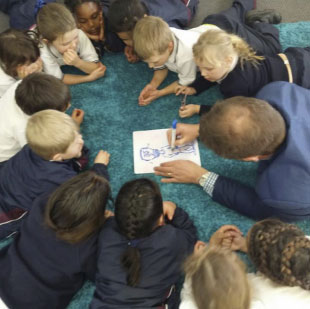 Download a printable copy of this article (PDF 183KB)
Download a printable copy of this article (PDF 183KB)
- Ensure circles serve better learning not interrupt it.
- Always seek maximum engagement.
- Run short, sharp circles as a default process.
- Whatever position students are in … so are you.
- Schedule some circles and run some circles just as you need them.
Getting everyone together in a circle is sometimes seen as the domain of the early childhood educator – but not for much longer. I see businesses running board meetings in circles. I see sporting coaches gathering their teams in circles at half time in preference to the usual clump. I see bands huddled in tight circles for a pep talk before bursting onto stage for a performance. What is making circles so universally popular?
We might like to think that the circle has some kind of magical property, but it really doesn’t. The key reason that circles work is rather bland and obvious – it’s because there are no powerful positions. In a circle, no one position is more important, more unique or more special than another. A circle, as it turns out, is a truly inclusive and accountable shape.
“The principles always work if you work the principles.”
– Jack Canfield
If using the dynamics of a circle to reduce power plays, to address bullying effectively and to drive up student engagement appeals to you, there are five principles worth keeping in mind. Commitment to these principles can help you to view circle work as highly valuable and to ensure that you shift from internal self-talk like “I don’t really have time for one of those circle today” to “I really don’t think I could teach this effectively without a few great circles.”
- Circles must serve your learning program.
The deployment of any circle activity should be directly connectable to an improvement in your students’ ability to learn deeply and effectively beyond the time the circle is running. If the circle is about emotions (check-in) then that should park or address concerns so that thinking is easier. If its focus is behavioural (preparation) it should reinforce learning behaviours. If it’s about content (learning) then it should prime students for knowledge absorption and application. - Engagement is everything.
Students who are in a circle should be engaged for as large a percentage of time as possible. That is, they are speaking, listening, speaking or doing. Resist going all the way around the circle in preference for “turn and talk”. Not all communication needs to be heard by the teacher or the whole class. - Less is more.
Set yourself a personal best for the fastest circle that you can run, and then try to beat it. While I allocated 15 minutes on a Monday morning for a check-in circle my average circle length would have been around 3 minutes – meaning I found an extra 12 minutes for maths. My record for a whole-class check-in circle is 40 seconds. - Position, position, position.
Circles don’t work because they are coated in pixie dust or because students are magically hypnotised into some positive behavioural trance. They work only because of the absence of powerful positions. When we take a chair while they sit on the floor, we adopt a powerful position and students immediately expect us to control their behaviour, resulting in their self-control being diminished. The positioning you can choose is up to you – sitting on the floor, sitting on chairs, standing or even lying on bellies. But whatever they do, you do too. You’ll find they mimic you rather than wait to be controlled by you, which is much more pleasant for all. - Be scheduled and flexible.
A little like the old tv show The Odd Couple you can have Felix Ungar circles which we are rigid, scheduled and determined about – usually weekly check-in and check-out circles. But you should also have Oscar Madison circles that you do spontaneously and flexibly. These are usually preparation, response and learning circles.
Keep these circle principles in mind and you’ll find quickly that circles aren’t something you squeeze in, but something you can’t get by without. The use of circles extends well beyond dealing with conflict or inappropriate behaviour choices. Done right, restorative circles are a powerful instructional tool that you can use to both improve your teaching effectiveness and reduce your stress levels.








